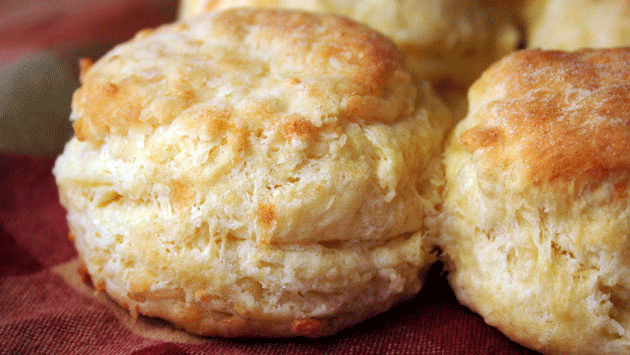The World’s Easiest, Quickest Scratch Biscuits
Butter is 15% water. In the hot oven, when the heat reaches the butter, it melts and the water turns to steam. The steam makes the biscuits tall, light, and flakey.
Pockets of butter is the key. As the butter melts and the water turns to steam, the biscuits laminate into layers. Well constructed biscuits will pull apart into flakey layers. A pastry knife cuts the butter into little chunks of butter and distributes it through the flour.
These are stir and bake biscuits—no pastry knife.
Without cutting the butter into the flour with a pastry knife, we needed to distribute the butter without cutting it into little chunks with a pastry knife. We used the oil and water principle: A fat—butter–will separate from water. And butter is a solid at temperatures below 80 degrees.
So, we poured melted butter into a bowl of cold milk. The warm butter separated and solidified in the cold milk into little pieces. It looked almost curdled. But when we mixed the “curdled” milk into the dry ingredients, it disbursed the little globs of butter through the batter. We stirred only as much as needed, scooped the batter onto parchment paper, and quickly hurried the biscuits to the oven.
The Results
We made these biscuits three ways: drop biscuits, cut biscuits, and cheese biscuits. The globs of butter were too small and too soft to get the true lamination of classic biscuits but we did get some separation of layers with the cut biscuits. The biscuits were light and airy and had a great flavor. And they’re quick. With all the ingredients on the counter and the butter melted, I could have a batch of biscuits in the oven in about five minutes.
Comparison of Biscuit Methods
So if you want to make biscuits, you have three alternatives.
- Use a mix. Prepared Pantry, of which I am an affiliate, has a great biscuit mix which is a just-add-water mix. The fat is already incorporated into the mix. (Yes, they do make dry shortening pieces.) Nothing is faster than a mix and this makes restaurant quality biscuits.
- Use a pastry knife. Make traditional biscuits. This is the slowest of the three but you can make great biscuits—flakey and laminated into layers.
- Use this method. It’s quicker than a pastry knife, almost foolproof, and makes good biscuits.
Easy Buttery Scratch Drop Biscuits
Because you don’t have to roll the dough and cut the biscuits, drop biscuits are faster than cut biscuit.
With this recipe, you add all the dry ingredients in a bowl, add melted butter to the cold milk, and the stir the milk mixture into the dry ingredients. We then used a lever-type ice cream scoop to quickly drop mounds of batter on the sheet.
If your ingredients are on hand, you’ll have biscuits in the oven in five to ten minutes.
Ingredients:
2 cups plus 2 tablespoons all-purpose flour
2 teaspoons baking powder
1/2 teaspoon baking soda
3/4 teaspoon salt
1 teaspoon sugar
2 tablespoons dry buttermilk
1 cup cold milk
1/2 cup butter, melted but cooled to warm (still liquid)
Directions:
Preheat the oven to 425 degrees. Line a baking with parchment paper.
- In a large bowl, whisk the flour, baking powder, baking soda, salt, sugar, and buttermilk powder together.
- Pour the melted butter into the cold milk, whisking until the butter solidifies and the milk looks curdled.
- Make a well in the dry ingredients and pour in the liquid mixture. Stir with a fork just until the batter clumps and form a wet mound in the bottom of the bowl.
- Using a 1/4 cup (2-inch diameter) ice cream scoop (4 ounce), scoop the batter from the bowl onto the parchment paper, leaving just enough distance between the biscuits for expansion. The mounds should be about 1 1/2-inchs high.
- Bake just until the tops of the biscuits are golden brown, ten to twelve minutes. Remove the pan from the oven and brush the tops of the biscuits with butter, if desired. Remove the biscuits to racks to cool and serve while still hot.
What can go wrong?
The goal is to have little lumps of butter distributed through the dough. If you handle the dough too much or leave it on the counter too long, the butter will melt and be absorbed into the dough.
The milk has to be cold and the butter cool enough that it sets into lumps when you pour the warm butter into the milk. Let the butter cool after mixing. For reference, we tested the temperature of the melted butter when we poured it into the warm milk. It was 100 degrees. At 100 degrees, it will feel very lukewarm to the touch, almost the temperature of your body.
Easy Buttermilk Biscuits
This is an easy way to make biscuits. They are not as flakey as biscuits with the fat cut in but they are good and simple to make.
Ingredients:
2 1/3 cups all-purpose flour
2 teaspoons baking powder
1/2 teaspoon baking soda
1 teaspoon salt
1 teaspoon sugar
2 tablespoons dry buttermilk
3/4 cup cold milk
1/2 cup butter, melted but cooled to warm (still liquid)
Directions:
Preheat the oven to 425 degrees. Line a baking with parchment paper.
- In a large bowl, whisk the flour, baking powder, baking soda, salt, sugar, and buttermilk powder together.
- Pour the melted butter into the cold milk, whisking until the butter solidifies and the milk looks curdled.
- Make a well in the dry ingredients and pour in the liquid mixture. Stir with a fork just until the batter comes together into a soft, irregular dough ball. Do not over mix.
- Dump the dough onto the counter and pat to a thickness of 3/4-inch. Cut the biscuits with a biscuit cutter and place them on the parchment paper.
- Bake just until the tops of the biscuits are golden brown, ten to twelve minutes. Remove the pan from the oven and brush the tops of the biscuits with butter, if desired. Remove the biscuits to racks to cool and serve while still hot.
The goal is to have little lumps of butter distributed through the dough. If you handle the dough too much or leave it on the counter too long, the butter will melt and be absorbed into the dough.
The milk has to be cold and the butter cool enough that it sets into lumps when you pour the warm butter into the milk. Let the butter cool after mixing. For reference, we tested the temperature of the melted butter when we poured it into the warm milk. It was 100 degrees. At 100 degrees, it will feel very lukewarm to the touch, the temperature of your body.
Easy Cheesy Biscuits
It’s hard to get enough cheese flavor with grated cheese. So we turned to a dry cheese powder. Even with a half cup of dry cheddar cheese, I didn’t think it was cheesy enough—though Debbie did. This recipe has a teaspoon of cheese boost. If you want it cheesier yet, you can increase the dry cheese to 2/3 cup or add another teaspoon of cheese boost.
Ingredients:
2 cups all-purpose flour
1/2 cup dry cheese powder
1 teaspoon cheese booster
2 teaspoons baking powder
1/2 teaspoon baking soda
1 teaspoon sugar
1 cup cold milk
1/2 cup butter, melted but cooled to warm (still liquid)
Directions:
Preheat the oven to 425 degrees. Line a baking with parchment paper.
- In a large bowl, whisk the flour, cheese powder, cheese boost, baking powder, baking soda, salt, sugar, and buttermilk powder together.
- Pour the melted butter into the cold milk, whisking until the butter solidifies and the milk looks curdled.
- Make a well in the dry ingredients and pour in the liquid mixture. Stir with a fork just until the batter comes together into a soft, irregular dough ball. Do not over mix.
- Dump the dough onto the counter and pat to a thickness of 3/4-inch. Cut the biscuits with a biscuit cutter and place them on the parchment paper.
- Bake just until the tops of the biscuits are golden brown, ten to twelve minutes. Remove the pan from the oven and brush the tops of the biscuits with butter, if desired. Remove the biscuits to racks to cool and serve while still hot.
The goal is to have little lumps of butter distributed through the dough. If you handle the dough too much or leave it on the counter too long, the butter will melt and be absorbed into the dough.
The milk has to be cold and the butter cool enough that it sets into lumps when you pour the warm butter into the milk. Let the butter cool after mixing. For reference, we tested the temperature of the melted butter when we poured it into the warm milk. It was 100 degrees. At 100 degrees, it will feel very lukewarm to the touch, the temperature of your body.
So here are the key points for you:
- You can make remarkable biscuits without cutting the butter or shortening into the flour with a pastry knife.
- By pouring melted butter into cold milk, you create a liquid with little floating globules of butter. When you stir the liquid into the dry ingredients, the bits of butter are dispersed through the flour.
- The pockets of butter are what create the texture of a biscuit.






